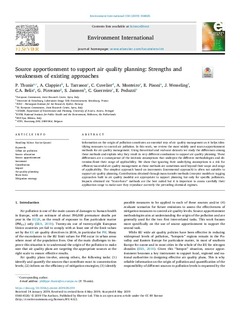| dc.contributor.author | Thunis, Philippe | |
| dc.contributor.author | Clappier, A. | |
| dc.contributor.author | Tarrasón, Leonor | |
| dc.contributor.author | Cuvelier, Cornelis | |
| dc.contributor.author | Pisoni, E. | |
| dc.contributor.author | Wesseling, J. | |
| dc.contributor.author | Belis, Claudio A. | |
| dc.contributor.author | Pirovano, G. | |
| dc.contributor.author | Janssen, S. | |
| dc.contributor.author | Guerreiro, Cristina | |
| dc.contributor.author | Peduzzi, E. | |
| dc.date.accessioned | 2019-07-17T12:31:31Z | |
| dc.date.available | 2019-07-17T12:31:31Z | |
| dc.date.created | 2019-06-21T09:34:08Z | |
| dc.date.issued | 2019 | |
| dc.identifier.citation | Environment Interatnional. 2019, 130, 104825 | nb_NO |
| dc.identifier.issn | 0160-4120 | |
| dc.identifier.uri | http://hdl.handle.net/11250/2605673 | |
| dc.description.abstract | Information on the origin of pollution constitutes an essential step of air quality management as it helps identifying measures to control air pollution. In this work, we review the most widely used source-apportionment methods for air quality management. Using theoretical and real-case datasets we study the differences among these methods and explain why they result in very different conclusions to support air quality planning. These differences are a consequence of the intrinsic assumptions that underpin the different methodologies and determine/limit their range of applicability. We show that ignoring their underlying assumptions is a risk for efficient/successful air quality management as these methods are sometimes used beyond their scope and range of applicability. The simplest approach based on increments (incremental approach) is often not suitable to support air quality planning. Contributions obtained through mass-transfer methods (receptor models or tagging approaches built in air quality models) are appropriate to support planning but only for specific pollutants. Impacts obtained via “brute-force” methods are the best suited but it is important to assess carefully their application range to make sure they reproduce correctly the prevailing chemical regimes. | nb_NO |
| dc.description.abstract | Source apportionment to support air quality planning: Strengths and weaknesses of existing approaches | nb_NO |
| dc.language.iso | eng | nb_NO |
| dc.rights | Navngivelse 4.0 Internasjonal | * |
| dc.rights.uri | http://creativecommons.org/licenses/by/4.0/deed.no | * |
| dc.title | Source apportionment to support air quality planning: Strengths and weaknesses of existing approaches | nb_NO |
| dc.type | Journal article | nb_NO |
| dc.type | Peer reviewed | nb_NO |
| dc.description.version | publishedVersion | nb_NO |
| dc.rights.holder | © 2019 The Authors. Published by Elsevier Ltd. | nb_NO |
| dc.source.volume | 130 | nb_NO |
| dc.source.journal | Environment International | nb_NO |
| dc.identifier.doi | 10.1016/j.envint.2019.05.019 | |
| dc.identifier.cristin | 1706661 | |
| cristin.unitcode | 7460,58,0,0 | |
| cristin.unitcode | 7460,55,0,0 | |
| cristin.unitname | Administrasjon | |
| cristin.unitname | Miljøeffekter og bærekraft | |
| cristin.ispublished | true | |
| cristin.fulltext | original | |
| cristin.qualitycode | 1 | |

